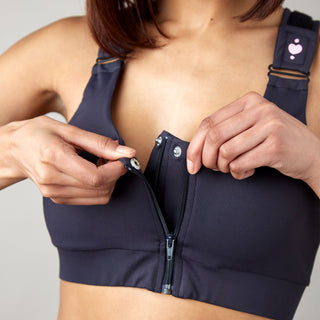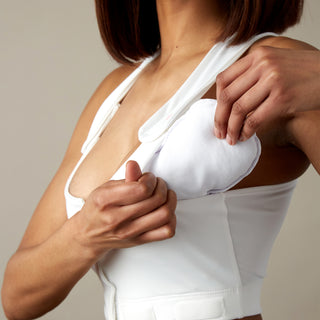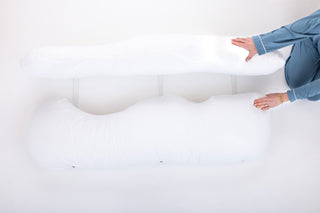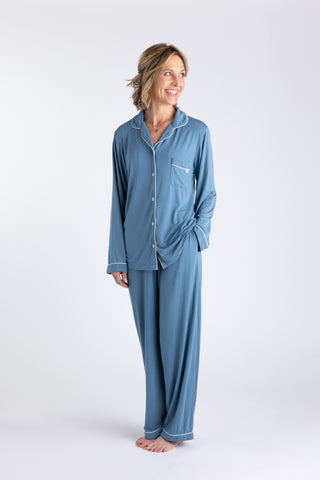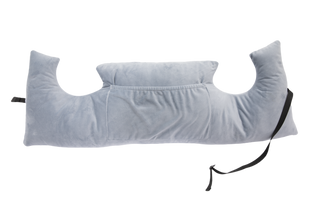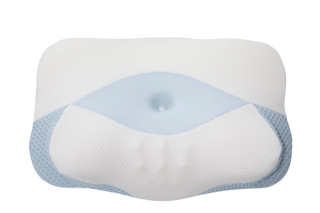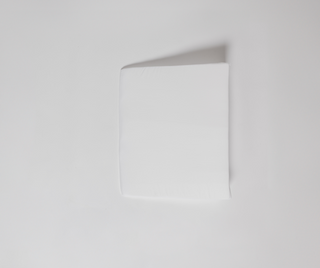Let's be real: nobody prepares you for the post-liposuction bra shopping experience. One day you're researching the perfect surgeon, and the next you're staring at a confusing array of compression garments wondering which one will actually help your recovery—and which ones are just expensive sports bras in disguise.
If you're facing liposuction recovery, especially involving the chest, breast, or upper body areas, the right compression bra isn't just about comfort (though that matters too). It's a medical necessity that can dramatically impact how well and how quickly you heal. Think of it as your recovery teammate—working 24/7 to support your body while it does the hard work of healing.
The difference between a regular bra and a post-liposuction compression bra is like comparing a Band-Aid to a medical dressing. They might look similar on the surface, but one is designed for everyday wear while the other is engineered to support your body's healing process at the cellular level.
This guide cuts through the confusion to help you understand exactly what your body needs during liposuction recovery, how compression bras actually work to accelerate healing, and which features make the difference between a smooth recovery and unnecessary complications.
Why Specialized Bras Matter More Than You Think After Liposuction
Here's a question that catches many patients off guard: "I got liposuction on my arms/back/chest—why do I need a special bra instead of just compression on the treated area?" It's a perfectly logical question that highlights something most people don't realize about how upper-body healing actually works.
The truth is, your upper body functions as an interconnected system. When liposuction disrupts tissues in your chest, arms, or back, it doesn't just affect that isolated area—it impacts the entire support structure of your upper body. Your regular bra, no matter how supportive, wasn't designed to work with healing tissue, altered circulation patterns, or the specific pressure requirements your body needs during recovery.
Why Regular Bras Actually Work Against Your Recovery
Your everyday bras are engineered for healthy, stable tissue. They rely on specific pressure points—underwires against your ribcage, straps pulling on your shoulders, bands that may dig in slightly—that become problematic when you're healing from surgery. These pressure points can restrict the very circulation your healing tissues desperately need.
Moreover, regular bras often create compression in some areas while leaving gaps in others. After liposuction, you need consistent, graduated pressure across all affected areas, not the uneven support that regular bras provide. That underwire that felt fine before surgery? Now it's a barrier to proper fluid drainage. Those adjustable straps that worked perfectly? They're not designed for the daily swelling fluctuations that happen during recovery.
The Domino Effect of Upper Body Surgery
When you have liposuction in the chest, arm, or back area, it creates a domino effect throughout your upper body. Remove fat from the armpit area, and suddenly your breast support system is affected. Contour the chest area, and your entire torso needs different support patterns during healing.
This is why general compression garments—like the ones used for leg or abdomen procedures—don't work for upper body liposuction. Your chest and breast area have unique support needs that require specialized engineering. You need compression that works with breast tissue, accommodates natural movement, and provides therapeutic pressure without the problematic features of regular lingerie.
The Support System Your Body Actually Needs
During liposuction recovery, your body needs external support to replace what was temporarily disrupted during surgery. Think of specialized compression bras as a dedicated support partner for your healing process. They provide the consistent assistance that allows your body to focus energy on healing rather than compensating for missing support systems.
This specialized support also needs to accommodate the reality of recovery: changing body shapes, surgical drains, sensitive incision sites, and limited mobility. Regular bras aren't just inadequate for these needs—they can actually interfere with optimal healing by creating pressure points, restricting drainage, or requiring movements that strain healing tissues.

Understanding Post-Liposuction Recovery: What Your Body Needs
Liposuction might seem straightforward—remove fat, look better, done—but your body's healing process involves multiple complex changes happening simultaneously. During the procedure, your surgeon disrupts tissue structure to remove fat cells, temporarily affecting your body's normal fluid balance and support systems.
Your body responds exactly as it should: with inflammation and fluid production to heal the treated areas. However, this natural response creates challenges that proper compression helps manage:
Swelling and Fluid Management: Your body produces extra healing fluid, but disrupted tissue structure means this fluid doesn't drain efficiently. Without compression, excess fluid pools in surgical areas, causing prolonged swelling and potentially uneven results.
Tissue Settling: Your skin needs to contract and settle into new contours over weeks and months. Consistent, gentle pressure encourages smooth, even healing and optimal skin retraction during this settling process.
Circulation Support: Healing temporarily affects circulation in treated areas. Your body must establish new pathways for blood flow and lymphatic drainage. Compression supports circulation while your body rebuilds these essential systems.
Scar Tissue Formation: Internally, your body forms new connective tissue to replace what was disrupted. Proper compression guides this process, encouraging smooth, flexible scar tissue rather than thick, irregular scarring that could affect your final contours.
Throughout your recovery, consistent compression support plays a vital role in optimizing your outcome.
SHOP THE BEST BRAS FOR LIPOSUCTION RECOVERY
The Science Behind Compression: How Recovery Bras Actually Help
Compression therapy isn't just about squeezing everything tight and hoping for the best. There's legitimate medical science behind how the right compression supports your body's natural healing processes after liposuction.
Reducing Swelling Through Pressure Gradient
Quality compression bras apply what's called a pressure gradient—slightly more pressure in areas where fluid tends to accumulate and less pressure where you want that fluid to move. This creates a gentle current that encourages excess fluid to flow toward areas where your lymphatic system can process it more effectively.
Think of it like having a training partner who knows exactly how to guide your movements. The compression bra creates gentle guidance that encourages excess fluid to flow toward areas where your lymphatic system can process it more effectively.
Supporting Tissue Structure
After fat removal, the surrounding tissues lose their natural support system. The compression bra acts as a reliable support partner, holding everything in the right position while your body rebuilds its internal support structures. This is particularly important in the chest and breast area, where gravity constantly pulls on healing tissues.
Enhancing Circulation and Healing
Proper compression actually improves circulation rather than restricting it. The gentle, consistent pressure helps pump blood and lymphatic fluid through the treated areas, delivering oxygen and nutrients while removing waste products that can slow healing.
This enhanced circulation helps reduce the risk of complications like seromas (fluid collections) and can speed up the resolution of bruising and swelling. It's like having a workout partner who keeps you moving when you want to quit—the compression keeps your circulation active when your body wants to slow down during healing.
Minimizing Scar Tissue Problems
As your body forms new connective tissue to replace what was disrupted during surgery, compression helps guide this process. The gentle pressure encourages the formation of smooth, flexible scar tissue rather than thick, rope-like scars that could create irregularities in your final contours.
This is particularly important in areas like the chest where you want smooth, natural-looking results. The compression helps ensure that your body's healing process works toward your aesthetic goals rather than against them.
Pain and Discomfort Management
Beyond the mechanical benefits, compression provides significant comfort benefits. The gentle pressure can reduce nerve sensitivity in healing areas, providing a soothing effect similar to how pressure helps relieve other types of pain.
Many patients find that proper compression allows them to move more comfortably during recovery, which actually speeds healing by promoting better circulation and preventing the stiffness that can develop when people avoid movement due to discomfort.


Essential Features for Post-Liposuction Bras
Not all compression bras are created equal, and when you're investing in your recovery, the details matter. Here's what separates truly therapeutic compression bras from basic shapewear that might look similar but won't support your healing process.
Compression Level and Distribution
Light compression should be distributed evenly across the treatment area without creating pressure points that could restrict circulation or cause discomfort. Quality compression bras achieve this through careful pattern design and graduated compression zones.
Materials That Work With Your Body
The fabric blend in your compression bra directly impacts both effectiveness and comfort during the weeks or months you'll be wearing it:
Premium Fabric Blends: Look for high-quality combinations like 95% nylon/5% spandex that maintain consistent compression without losing shape over time.
Moisture-Wicking Technology: Healing surgical sites need to stay dry to prevent complications. Advanced moisture-wicking fabrics actively pull sweat away from your skin.
Antimicrobial Properties: Many quality compression bras incorporate antimicrobial treatments for additional protection of sensitive, healing skin.
Breathability: The fabric must balance firm compression with air circulation for optimal healing.
Design Elements That Make Recovery Easier
Small design details can have an enormous impact on your daily comfort and recovery experience:
Front Closure Systems: After upper body liposuction, reaching behind your back can be uncomfortable or even impossible initially. Front-closing bras become essential rather than convenient. Look for closures that provide security without creating pressure points against healing tissues. heart&core’s surgical bra design includes front closures specifically for post-surgical needs, ensuring easy operation even with limited mobility while maintaining proper compression.
Adjustability Features: Your body changes throughout recovery—sometimes daily in the early weeks. Wide, medical-grade adjustable straps allow you to modify fit as swelling changes without compromising compression effectiveness.
Seamless Construction: Seams can irritate sensitive post-surgical skin. Quality compression bras use seamless construction techniques or place seams strategically away from healing areas.
Wide, Cushioned Straps: Traditional bra straps can dig into shoulders when wearing compression garments for extended periods. Wide, cushioned straps distribute pressure and prevent discomfort that comes with all-day wear.
Drain Management Features: Early recovery often involves surgical drains. Some specialized compression bras include built-in drain management systems with secure holders that keep drains positioned properly without compromising compression.
Coverage Considerations
Post-liposuction compression bras typically provide more extensive coverage than regular bras:
Higher Necklines: Additional coverage in the chest area ensures compression extends to all treated areas, particularly important for procedures involving the upper chest or armpit regions.
Extended Band Coverage: Wider bands around the torso provide more comprehensive compression and prevent the rolling or shifting that can occur with narrow bands during extended wear.
Racerback or Wide-Back Design: These designs provide better support and prevent straps from sliding off shoulders—a common problem when wearing compression garments for long periods.
SHOP THE BEST BRAS FOR LIPOSUCTION RECOVERY
Matching Bra Types to Liposuction Areas
Different liposuction procedures require different approaches to compression support. Understanding how your specific procedure impacts your compression needs helps you choose the most effective recovery bra.
Breast and Chest Liposuction
When liposuction involves the breast tissue or chest area, your compression needs become more complex. The breast tissue requires gentle but consistent support to maintain shape during healing, while treated areas need therapeutic compression.
For breast liposuction, look for bras that provide:
-
Consistent compression across the entire treatment area
-
Adjustability to accommodate changes in breast size during healing
-
Soft, seamless construction that won't irritate sensitive nipple areas
heart&core's post-surgical bras are specifically designed with these considerations in mind, offering the gentle but effective compression needed for optimal breast area recovery while maintaining comfort during extended wear periods.
Upper Body and Combined Procedures
Liposuction in the armpit area or upper chest requires compression bras with extended coverage. These areas are particularly prone to fluid accumulation and swelling, making consistent compression crucial for optimal results.
For upper body and combination procedures, you may need:
-
High-coverage design that extends into the armpit area
-
Variable compression zones for different healing requirements
-
Enhanced support systems for increased surgical trauma
-
Features like breast form pockets if reconstruction is involved
Your Recovery Timeline: When and How Long to Wear
Understanding what to expect during each phase of recovery helps you use compression therapy most effectively. Your surgeon will provide specific guidelines, but here's what's typical for most liposuction procedures.
Immediate Post-Surgery Phase (Days 1-14)
Consistent compression during these crucial first two weeks can significantly impact your final results.
-
Typical wear: 24 hours a day, removing only for brief showers
-
What to expect: Maximum swelling, some discomfort, daily changes in fit
-
Key focus: Preventing fluid accumulation, supporting initial healing
Early Recovery Phase (Weeks 2-6)
Swelling begins to subside, but tissue settling continues.
-
Typical wear: 12-18 hours daily, with breaks for comfort
-
What to expect: Gradual swelling reduction, improved comfort, more stable fit
-
Key focus: Supporting tissue settling, maintaining circulation improvements
Maintenance Phase (Weeks 6-12+)
Most major swelling has resolved, but tissue settling continues for months.
-
Typical wear: Varies by individual and surgeon recommendation
-
What to expect: Near-final results visible, occasional minor swelling with activity
-
Key focus: Supporting final tissue settling, maintaining results
Signs It's Time to Transition
Common indicators include stable minimal swelling, comfortable range of motion without compression, tissues that feel settled and stable, and surgeon clearance based on your healing progress.
Care, Maintenance & Practical Living
Let's talk about the reality of living with compression bras during recovery. These aren't just garments you throw in the hamper—they're medical devices that require proper care to maintain their effectiveness throughout your healing process.
Proper Care for Maximum Lifespan
Your compression bras work hard during recovery, and proper care ensures they maintain therapeutic pressure throughout your healing period:
Washing Guidelines: Hand washing is ideal, but if you need to use a machine, use a lingerie bag and gentle cycle. Harsh detergents can break down the elastic fibers that provide compression, so stick with mild, fragrance-free soap. Skip the fabric softener entirely—it can coat fibers and reduce compression effectiveness.
Drying Best Practices: Air drying is non-negotiable. The high heat from dryers destroys the elastic components that provide therapeutic compression. Lay flat or hang to dry, and resist the urge to speed things up with heat sources.
Rotation Strategy: You'll need multiple compression bras for your recovery—one to wear while washing the other. heart&core offers bundle discounts that make having multiple bras more affordable while ensuring you're never without proper compression during recovery.
Having multiple bras isn't just about convenience—it's about ensuring consistent compression therapy. When your compression bras lose their elasticity from overwashing or overuse, they stop providing the therapeutic pressure your healing body needs.
Wardrobe Integration During Recovery
Let's address the elephant in the room: compression bras don't always play nicely with your regular wardrobe. But with some strategic planning, you can maintain your style while prioritizing your healing:
Layer Strategically: Loose-fitting tops with higher necklines work best with compression bras. Flowing fabrics camouflage the medical look while keeping you comfortable.
Embrace Adaptive Fashion: Many clothing lines now offer stylish options designed for post-surgical needs. These pieces look great while accommodating the realities of recovery wear.
Color Considerations: While medical white is standard, some brands offer skin tones and darker colors that won't show through lighter clothing. Choose colors that work with your existing wardrobe to reduce the need for entirely new clothes during recovery.
Managing Comfort vs. Effectiveness
Here's the truth: the level of compression needed for optimal healing might not feel comfortable initially. This balance between therapeutic benefit and comfort improves over time, but understanding what to expect helps maintain the consistency that makes compression therapy effective.
Initial Adjustment Period: Most patients need 3-7 days to adjust to wearing compression bras for extended periods. This is normal and doesn't mean the bra doesn't fit properly.
Pressure Point Monitoring: Red marks that fade within 15 minutes of removal are normal. Marks that persist or cause numbness indicate too much pressure—contact your surgeon if this occurs.
Comfort Modifications: Some patients add soft padding to areas where straps might rub or use barrier creams to prevent chafing during extended wear periods.
The Reality of Extended Wear
Wearing compression bras for weeks or months requires mental as well as physical adjustment. Here's how to make it manageable:
Set Realistic Expectations: Some days the bra will feel more comfortable than others. Swelling fluctuates, hormones change, and your body's tolerance varies—this is all normal.
Create Comfort Rituals: Brief removal periods for skin care, gentle massage, or simply giving your body a break can help with psychological adaptation to extended wear.
Focus on the Goal: Remember that temporary discomfort serves a purpose. Every day of consistent compression contributes to better final results and potentially shorter overall recovery time.
Replacement Timeline
Even with excellent care, compression bras eventually lose their therapeutic effectiveness. Plan to evaluate replacement needs every 4-6 months with regular use, or sooner if you notice:
-
Reduced compression sensation
-
Fabric stretching that doesn't return to original shape
-
Worn elastic that no longer provides even pressure
-
Changes in fit that aren't related to your body changing
Investing in quality compression bras from companies that specialize in post-surgical recovery pays off in both durability and therapeutic effectiveness throughout your healing journey.
FAQ: Your Top Questions About Post-Liposuction Compression Bras
How long after liposuction do I need to wear a compression bra?
Most surgeons recommend 4-6 weeks minimum, with some patients benefiting from extended wear up to 12 weeks. Follow your surgeon's recommendations rather than general timelines.
Can I sleep in my compression bra?
Yes, most compression bras designed for post-liposuction recovery are safe for overnight wear. Maintaining compression during sleep is often recommended, especially in the first few weeks.
How tight should my compression bra feel?
Your compression bra should feel snug and supportive without causing pain, numbness, or restricting breathing. You should be able to slip one finger under the band comfortably.
How many compression bras do I need for recovery?
At minimum, you need two—one to wear while washing the other. Three is ideal for comfortable rotation and to extend the life of each bra.
When can I switch to a regular bra after liposuction?
Most patients can gradually transition to regular bras after 6-8 weeks, starting with short periods. Your surgeon will guide this transition based on your healing progress.
Will insurance cover my compression bras?
Coverage varies widely. Some plans cover compression garments with a prescription from your surgeon. Contact your insurance provider directly to understand your specific coverage.
Can I exercise while wearing my compression bra?
Light exercise while wearing compression bras is often encouraged and can aid recovery by improving circulation. Follow your surgeon's activity restrictions and start slowly.
What if my compression bra starts to feel loose during recovery?
This is completely normal as swelling decreases throughout recovery. If your bra feels significantly looser, it may no longer be providing adequate compression. First, try adjusting the straps and band for a snugger fit. If adjustments don't restore proper compression, you may need to size down or consider a bra with more adjustability features.
heart&core’s compression bras are designed with medical-grade adjustable straps specifically for this reason - they can accommodate the significant changes that happen during recovery. Some patients find they need to transition through 2-3 different sizes during their full recovery period. Don't continue wearing a bra that feels loose, as it won't provide the therapeutic compression your healing tissues need.
Disclaimer
This article is intended for informational purposes only and should not be considered medical advice. Always consult with your plastic surgeon or healthcare provider about your specific post-liposuction recovery needs, including appropriate compression levels, wear schedules, and any concerns about your healing progress.
Individual results and recovery timelines vary significantly based on procedure type, extent, individual healing factors, and adherence to post-operative instructions. The compression bra features and recommendations discussed in this article are general guidelines—specific product choices should be made in consultation with your surgical team.
While compression therapy is a widely accepted component of liposuction recovery, it is most effective when used as part of a comprehensive post-operative care plan developed with licensed medical professionals familiar with your specific procedure and medical history.


